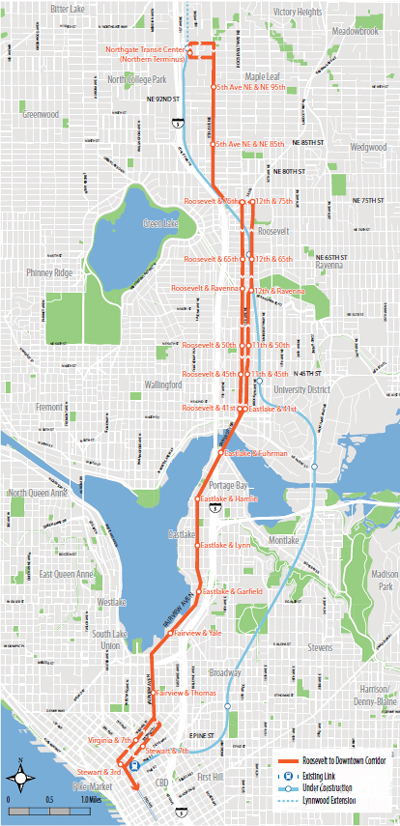
The Seattle Department of Transportation (SDOT) is moving ahead with the Roosevelt HCT project. SDOT will provide an update on project development this month with two open houses. Concept designs for bus rapid transit (BRT) will be revealed. Originally, the project evaluated a variety of high capacity transit (HCT) options for the corridor, but in Fall 2015 the agency strongly pointed toward to BRT technology for the corridor, or what SDOT is calling RapidRide+.
The corridor would connect neighborhoods from Downtown Seattle to Northgate, including South Lake Union, Eastlake, University District, Roosevelt, and Maple Leaf. Buses would generally follow the corridor via five segments:
- Third Avenue in Downtown;
- A couplet on Virginia Street and Stewart Street through the Denny Triangle and Westlake Avenue in South Lake Union;
- Fairview Avenue and Eastlake Avenue through Eastlake;
- A couplet on Roosevelt Way and 11th Avenue in the University District and Roosevelt; and
- 5th Avenue through Maple Leaf and Northgate.
With RapidRide+ investment in the corridor, SDOT is looking at a menu of options to attain high quality bus service:
- Exclusive bus lanes and BAT lanes at certain locations;
- Queue jumps and signal priority along most of the route;
- Electrification of the route;
- Off-board payment and real-time information signs at stops;
- Larger and enhanced stop facilities; and
- Three-door boarding of buses to speed movement of passengers on and off.
During the December meetings, there was ample discussion on the degree of dedicated right-of-way that SDOT was proposing for BRT. Many felt that the proposal didn’t go far enough in ensuring faster service through the corridor. Walking and bicycle advocates also pressed SDOT to provide high quality facilities for bikes and pedestrians along the corridor. There was a particular emphasis on separated bicycle facilities on Eastlake Avenue and the Roosevelt couplet. Conditions on those streets are relatively poor for those walking and biking, but there is widespread support for improvements. The main challenge is the right-of-way width through Eastlake which is fairly squeezed even under today’s roadway layout. SDOT’s concept will likely provide more direction on how these issues will be addressed and more specifications on the type of BRT service that the corridor will receive.
Open Houses
Eastlake
Wednesday, June 15th from 6pm to 8pm
TOPS School Cafeteria
2500 Franklin Avenue E
University District
Thursday, June 16th from 6pm to 8pm
UW Tower North Cafeteria
4333 Brooklyn Avenue NE
Stephen is a professional urban planner in Puget Sound with a passion for sustainable, livable, and diverse cities. He is especially interested in how policies, regulations, and programs can promote positive outcomes for communities. With stints in great cities like Bellingham and Cork, Stephen currently lives in Seattle. He primarily covers land use and transportation issues and has been with The Urbanist since 2014.



